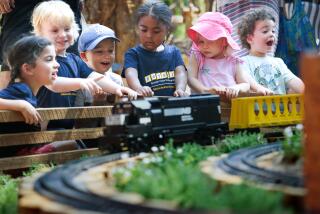Teacher Uses Toy Trains for Training Young Minds
- Share via
LEHI, Utah — There’s rarely an argument about whether model trains capture the imagination of a child; it’s a given.
But at Thanksgiving Point Institute, just north of Provo, there’s a giant model train that came from the imagination of a grown-up. He hopes it will help to teach children and adults about a wide range of subjects, from math and physics to robotics, computer science and design.
Tom Catherall, a Brigham Young University graduate and an associate dean of the College of Health and Human Performance, has been teaching with trains for 14 years. Right now he’s in the middle of his biggest project and the largest of its kind in the country, which he says will get kids excited about learning.
You can call the 57-year-old model-train guru crazy, but don’t call his motives loco.
“We’re hoping to encourage a lot of school groups to come out,” Catherall said. “We’ve built a lot of educational components into this.”
Kids can be taught how to figure out the average speed and scale speed of the trains, which meander through Swiss, American West and mining villages throughout the 300-by-150-foot outdoor garden.
“It’s widely diversified,” said Edward Bosley, who has been driving from Salt Lake City, volunteering his time to get the train up and running.
Bosley says he’s been hooked on trains since he got one for Christmas as an 8-year-old. At age 60 he’s a member of the Utah Garden Railway Society. The group, which has about 30 members, had been loosely formed until a year ago, when it became involved in building the railway. The society now calls this home and hopes to recruit through it.
Members of the club built the foundation, laid more than 4,000 feet of track and now monitor the train for kinks that arise among the 20 trains run for--and sometimes by--the ticket-buying public.
There are control boxes at the bottom of a winding path that allow visitors to walk with the trains as they hum along the tracks. Children are encouraged to use the boxes to control the speed and direction of the trains, and these boxes will be central to the lessons they learn.
But remember, they are kids.
“They really want to see the trains crash,” Catherall said.
After the exhibit opened recently, three boys walked down the sidewalk looking as if they might be a little too cool for the train. One of them, Jared Stuart, 10, lagged behind the others to get into a control box that is not supposed to be used by guests. Then he offered his opinion about who plays with trains.
“Little babies,” he said, as his brother, Chase, 14, and friend C.J. Harrison, 10, cracked up.
When asked what they think about getting out of school to come here and learn their math and science hands-on, it’s a different story.
“Yeah,” said Harrison. “It’s better than doing schoolwork.”
Jared concluded that as long as the train is as big as this one, it’s OK to play with them “whenever you want,” regardless of your age.
With that, they moved on to try their hands at being engineers.
Catherall says the exhibit is only about 80% complete, but most of the remaining work is decorative or landscape-related. Most of the 1,300 miniature buildings are set up, and the general construction is finished, including a 25-foot-high Matterhorn-like mountain the trains zip through and around.
With the elegant landscaping that’s been done in the surrounding 55 acres of gardens at Thanksgiving Point, Catherall is looking forward to the $500,000 project’s completion next spring.
Besides the train’s educational aspect, Catherall’s other goal is to provide a place for families to play at a reasonable price.
As the director of BYU’s Office of Youth Research and Development in the mid-1980s, Catherall and his colleagues set out to understand why the learning relationship between adults and their own children was different than it was when they were teaching someone else’s children. They tried to find their answer using games, sports and other educational tools. None worked.
He then came across a journal article about marriage counselors who used trains to get husbands and wives interacting. He looked into it, and sure enough. . . .
“Trains were compelling,” Catherall says. “People didn’t care if others were observing and doing research and monitoring what they were saying to each other. They just wanted to play with the trains.”
More to Read
Sign up for The Wild
We’ll help you find the best places to hike, bike and run, as well as the perfect silent spots for meditation and yoga.
You may occasionally receive promotional content from the Los Angeles Times.





